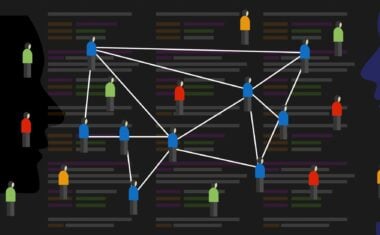Careers in machine learning and data science have seen explosive growth in recent years. Machine learning, in particular, is a flourishing and rapidly evolving field offering tremendous opportunities for advancement. A recent report from Indeed showed that Machine Learning (ML) Engineering jobs outpaced all others in salary, demand, and growth.
That Indeed report also showed that the demand for machine learning engineers has risen by a staggering 344%, with an average base salary of $146,085. Whether you want to build ML algorithms as a developer or add data science capabilities to your business analysis toolbox, the right ML skills can completely transform your career trajectory.
Machine learning is also a core component of today’s most booming fields, including Big Data, Predictive Analytics, Data Mining, and Computational Statistics.
If data, automation, and algorithms excite you, then machine learning is a rewarding career choice. One of the most appealing facets of machine learning is that you learn skills much faster than you might think. All you need to get started are solid research skills and a baseline understanding of statistics and programming languages. People with all kinds of unique backgrounds, knowledge, and experiences can customize their ML learning paths.
Over time, as you grow your skill set, you can take advantage of the high demand and low supply in the industry. You will also have the freedom to branch into more specialized jobs like a Natural Language Processing (NLP) Scientist, Human-Centered Machine Learning Designer, or Business Intelligence Developer.
This guide will help you forge your own machine learning career path as you step into the fascinating world of artificial intelligence (AI).
What Is Machine Learning?
The term machine learning was first coined by the AI pioneer Arthur Samuel, who defined ML as the “field of study that gives computers the capability to learn without being explicitly programmed.”
Simply put, ML teaches machines to learn from experience, rather than being programmed for specific tasks. It is an exciting combination of statistics and computer science that enables machines to independently identify patterns in data.


Become a Data Scientist. Land a Job or Your Money Back.
Build job-ready skills with 28 mini-projects, three capstones, and an advanced specialization project. Work 1:1 with an industry mentor. Land a job — or your money back.
Machines are trained to make sense of large quantities of data by using various ML models and algorithms. The four basic approaches of classical ML are:
- Supervised learning
- Unsupervised learning
- Semi-supervised learning
- Reinforcement learning
Machine learning engineers choose their particular machine learning algorithm based on the kind of data available and the problem they’re trying to solve. As machines analyze more and more data, they become “smarter” and can adapt to new tasks and challenges. This imitates the way humans learn naturally—gradually building skills and improving accuracy.
While ML and AI have generated interest for decades, we now have the technology to fully realize its applications. Self-driving cars, automated chat boxes, speech recognition systems, and even video streaming recommendations all use ML processes.
Why Learn Machine Learning?
Machine learning is a skill of the future. Today’s leading companies—including Facebook, Google, and Uber—have made ML a central part of their operations. And with skyrocketing demand for ML professionals, the field faces a major skill shortage.
Understanding ML practically guarantees you a secure and lucrative career in the tech industry. With an extensive ML skill set, you can provide great value to your employer and boost your relevance in the job marketplace.
The field’s exponential growth also means that you’ll have the freedom to work in the industry of your choice. The World Economic Forum recently stated that “AI, Machine Learning, and automation will power the creation of 97 million new jobs by 2025.” As more companies embrace the utilities of ML, the average base salary of an ML engineer will only continue to rise in the coming years.
Machine learning is key to solving some of the biggest issues of the digital age. ML can help overcome critical challenges in banking and personal finance, healthcare diagnostics, image and speech recognition, and fraud prevention. Solutions to these problems will help people and businesses thrive, and contributing to such significant progress also creates a sense of great personal satisfaction.
The unique blend of engineering, discovery, and business application also means that ML can be incredibly fun! It is a vibrant field offering plenty of growth opportunities. If you are excited about jumping into interesting challenges and finding innovative solutions, you’ll enjoy every minute of the hands-on training and practice needed to learn ML.
What Does a Machine Learning Engineer Do?

On a day-to-day basis, ML engineers design, develop, test, and implement machine learning algorithms. Machine learning engineers use programming languages like Python, Scala, and Java to perform tasks and automate processes. They utilize statistical and programming skills to create and train machine learning models. The ultimate goal for an ML engineer is to develop self-learning applications that are both accurate and efficient.
The main responsibilities of an ML engineer include:
- Study complex computer architectures, data structures, and algorithms
- Work with data engineers to design machine learning systems
- Manage infrastructure, data, and model pipelines
- Ensure fidelity of datasets and data representation methods
- Analyze large, compound datasets to identify patterns and extract insights
- Develop algorithms based on statistical modeling procedures
- Build and maintain scalable machine learning solutions in production
- Display end-to-end understanding of data modeling and evaluation strategies
- Liaise with stakeholders and explain complex processes to people who are not programming experts
- Stay abreast of best practices and developments in the field
As the scope of the role suggests, an ML engineer needs to be proficient in several analytical fields. In addition to proven math and programming skills, you will also need to build outstanding problem-solving capabilities.
Learn Machine Learning in 9 Easy Steps
-
Learn the Prerequisites
-
Learn ML Theory From A to Z
-
Deep Dive Into the Essential Topics
-
Work on Projects
-
Learn and Work With Different ML Tools
-
Study ML Algorithms From Scratch
-
Opt For a Machine Learning Course
-
Apply for an Internship
-
Secure a Job
1. Learn the Prerequisites
Before you can learn the theory and applications of machine learning, you’ll first need to understand its most essential concepts. This foundation will help you learn ML principles more quickly by creating a systematic learning path.
Programming

All machine learning algorithms are implemented with code. So programming skills in Python, R, Bash, or Java are a must for any aspiring ML engineer. In recent years, Python has emerged as the most popular programming language, especially for beginners. It has simple syntax, extensive built-in functions, the most-supported libraries, and wide package support.
If you have no experience with programming, a beginner or crash course in Python is the best way to get started with ML. Once you have mastered its basic functionalities, you will need to learn how to extract, process, and analyze data. Most ML and data science courses will have a section dedicated to efficient data analysis.
Statistics and Probability
As machine learning engineers work almost exclusively with data and its predictions, both statistics and probability are fundamental topics in the ML field. All data-driven decisions are ultimately made based on the probabilities of compound events occurring. And descriptive statistics enable the transformation of raw data into meaningful information that is used to design and develop ML algorithms.
Together, statistics and probability comprise all the metrics and techniques needed to assess the relationships between data distributions. Deep knowledge of these subjects gives you an intuitive understanding of regression models that are built on frequentist statistical theory (for smaller data sets) or modern machine learning theory (for larger data sets).
Mathematics

Linear algebra and calculus are both integral to machine learning. The algorithms used to manipulate datasets are built on the foundation of linear algebra, particularly vector spaces and matrix operations. Linear algebra also covers crucial concepts like linear transforms, tensor and tensor rank, notations, and matrix multiplication.
While all aspiring ML engineers need a baseline understanding of calculus, more in-depth concepts are required for advanced projects. If you are just beginning, you might want to wait to learn some of the more sophisticated calculus topics. Either way, you’ll certainly need to grasp key calculus concepts like gradient and slope, integration and differentiation, partial derivatives, and multivariable operations.
Data Tackling
Last but not least, you’ll need to gain experience working with large volumes of data. If you can handle data, you can greatly improve your code’s efficiency in terms of the memory and time consumed. Before you can design or select a model for data analysis, you’ll need to clean your data (data wrangling) and estimate the structure of the whole set.
A deep understanding of data modeling functions will help you avoid future pitfalls and errors. It will also enable you to design better and faster algorithms that optimize processing. As you learn more about the nature of the data and the patterns to be identified, you can start experimenting with more advanced concepts, like predictive modeling and analytics.
2. Learn ML Theory From A to Z
Planning and Data Collection

When beginning any ML/AI project, start by planning for the type of events you are detecting and the metadata you will capture. The process generally starts by collecting a small amount of training data that can be used to validate the results in a proof of concept. Both continuous (status) events and discrete (trigger) events must be explicitly defined before data collection and validation can take place.
Data Assumptions
All machine learning models use certain assumptions to make predictions. Linear regression, logistic regression, decision tree, random forest, KNN (K-Nearest Neighbors), support vector machines (SVM), and all other ML models are based on some fundamental axioms or assumptions about the nature and behavior of the data. Data assumptions usually cover the relationship between the independent and dependent variables, their distribution, multicollinearity, autocorrelation, and outliers.
Data Preprocessing

Preprocessing, as the name suggests, is the process of formatting raw data to be processed by a machine learning model. It includes specific steps to transform or encode the data so that it can be easily parsed by the machine. Data preprocessing improves the accuracy and efficiency of the ML model by minimizing data noise, missing values, and system handling errors or unusable formats. Preprocessing steps also describe the appropriate splitting of the dataset into training and test sets.
Get To Know Other Data Science Students
Samuel Okoye
IT Consultant at Kforce
Mikiko Bazeley
ML Engineer at MailChimp
Corey Wade
Founder And Director at Berkeley Coding Academy
Data Interpretation Along With Model Results
Model interpretation in machine learning seeks to understand the model’s decision-making process. It systematically evaluates the fairness, reliability, trust, and causality of the model results. Put simply, it helps answer questions like “How trustworthy are the model’s predictions?” and “Are they reliable enough to shape major policies and decisions?” The two main ways to interpret ML models are model-specific/model-agnostic methods and local/global scope methods.
Improving and Bettering Your Models

Improving the accuracy of the ML model is essential to the overall project’s success. The model’s predictions need to have a low error range and perform well with different problem variables. While some methods deal with cleaning and filtering the data more efficiently, others suggest using varied strategies to improve the performance of the model with new, unused data. Techniques like cross-validation, feature engineering, and algorithm/hyperparameter tuning are popular choices for boosting the model’s precision.
Contributing to Business Value
When you’re building machine learning models for a client or employer, the performance of the model directly equates to money spent. Decisions predicated on an inaccurate model can be very costly for organizations. Aside from the financial loss, a low-accuracy model can lead to devastating errors, like an incorrect medical diagnosis. For these reasons, it is crucial for ML engineers to understand, from a business perspective, the value of correct predictions and the cost of incorrect ones.
3. Deep Dive Into the Essential Topics

Once you’ve grasped the underlying concepts, you will start to understand the capabilities and reasoning behind machine learning models. The final step before you can start contributing to the ML/AI community is to gain an end-to-end understanding of the sequence of operations in data science. This will help you understand how the data, ML, and software code pipelines interact with each other to create a complete product.
Practice Machine Learning Workflow
Strictly speaking, the machine learning pipeline starts with clean, filtered data that has been optimized for ML parsing. In practice, ML engineers also spend a substantial amount of time wrangling data to ensure that incomplete or noisy data doesn’t damage the model’s accuracy. After the data has been appropriately split into training and test sets, the preliminary code for the model can be created. This includes model engineering, evaluation, and packaging.
Using certain performance metrics like precision and recall, the model evaluation step determines the choice of the model. As the model is trained and refined over time, the “prototype” stage of the process is completed. The workflow then shifts to the “production” stage, where the model is deployed. The final stage is to measure the performance of the model by monitoring its predictions and analyzing the insights generated.
Work on Real Datasets
No matter what industry you plan to work in, you will need hands-on experience with real data to sharpen your skills. All real data is somewhat flawed, and so it provides an excellent opportunity to learn about the typical problems and solutions associated with data manipulation. Thanks to the incredible ML community, there are thousands of open-source aggregated datasets available to the public.
You can easily find computer vision data, climate change data, biological datasets, government databases, geographical/geospatial data, and even FBI crime data to use for your project. If you are new to handling data, you might want to select a smaller dataset or pick the most relevant information in a larger dataset. Make sure that the dataset you choose is suitable for beginners—it should have good quality data that is labeled consistently.
Learn Comprehensively

As in most emerging fields, it’s important to keep in mind the bigger picture when learning ML from scratch. It is not enough to grasp just the basics of a programming language—you need to learn about the different tools and packages that are specific to ML/data science. For example, if you are learning Python, you will need to gain a solid understanding of data analysis, manipulation, and visualization tools in pandas and NumPy.
If you prefer to learn as you go, instead of decoding algorithms from the ground up, you should focus on the applications of functions and algorithms in the scikit-learn library. You can then move on to learning topics like deep learning and neural networks, which are some of the most sophisticated fields in the industry.
As you further diversify your portfolio and dive into specializations, consider how your expertise can generate value for an organization. And consider getting involved in a community-driven learning system, such as competitive coding. This will help you keep pace with the most in-demand skills and the latest advancements in the industry.
4. Work on Projects
Working on your own projects is a must for any aspiring ML engineer. In the competitive ML marketplace, you need real-world experience to stand out from the sea of novice candidates. Employers look for professionals who have demonstrable first-hand experience with ML tools and applications. Taking up an independent project helps materialize your theoretical knowledge into a practical approach. The trial and error process of developing your project offers a great learning curve for beginners in the field.
There is an extraordinary variety of projects you can undertake to hone your ML skills. Sentiment analysis of product reviews, stock prices prediction, object detection, and even music and movie recommendations are all great examples of beginner-friendly machine learning projects. Keep in mind that there are several factors to consider before you can select the right project to start with.
Choose Based on Your Interest
While this might seem like an obvious or optional suggestion, you should select a topic you are truly interested in. When you start working on your first project, you are bound to make mistakes, especially if you’ve started from square one. These errors can become frustrating over time and you might not be able to make progress as quickly as you’d hoped. When this happens, it helps to have a topic that you genuinely care about.
Many aspiring ML engineers give up on their projects because of how tedious the process can be. You need to remember that learning from experimentation with different tools and strategies is the very goal of your first ML project. Spend some time going over different project options, their datasets, and the predictions they enable. Then pick the project that gets you excited about building a model for its base predictions.
Work on Basic Projects
Do not underestimate the expertise required to get through a complete ML project. Even after you’ve mastered the fundamentals, you will have to go through quite a bit of trial and error before you can establish a clear plan. So it’s important to choose a project that matches your skills and capabilities. Creating models for chatbots, image recognition, or housing prices are considered beginner-level projects, while models built with deep learning, progressive AI, or neural networks are advanced ML projects.
As a beginner, you should always start with a relatively simple project that will allow you to expand your skillset. Don’t select a more challenging project just because it might look better for your portfolio. You can always move on to more advanced topics after you have a couple of elementary projects under your belt. If you feel confident enough with your understanding of a beginner project, you can attempt intermediate-level projects, including market basket analysis, text summarization with natural language processing, a movie recommendation engine, or text mining.
Build Value-Adding Projects

To create a project that adds real value to the ML ecosystem—and your portfolio—you’ll need to focus on its business impact. Start by evaluating how your model is expected to drive business performance and what actionable metrics you’ll need to optimize for. In the initial stages, you should aim to create a minimum viable product (MVP). An MVP is a product that has just enough basic features to be deployed. Feedback from the system can then be utilized to improve accuracy and add features.
Keep in mind that even the first iteration MVP needs to add some of the value expected from the final model. If the MVP shows no hope of creating the desired value, you will need to restrategize your data and/or ML pipeline. As long as you’re on the right track with the first iteration, jumping into the production stage early will help you quickly improve your model. A simple, accurate, and interpretable model is always better for your resume than an arcane project that is unable to generate real-world value.
Here are some ideas to get you started with an ML project. This guide covers options from a wide range of different subjects that go from beginner to advanced levels in difficulty.
5. Learn and Work With Different ML Tools
There’s an extraordinary variety of ML tools and packages available in the market today. From data collection and preparation to model building and application deployment, the possible combinations are practically infinite. As a beginner, your best bet is to stick with tried and tested software and packages with proven capabilities. Of course, the choice of tools will also depend on the kind of model and prediction you’re trying to create. But there is a whole range of verified tools that perform exceptionally well for the vast majority of use cases.
Some of the most popular ML/AI tools trusted by experienced professionals are:
- TensorFlow
- Auto-WEKA
- KNIME
- Google Cloud AutoML
- BigML
- Scikit-learn
- Azure Machine Learning Studio
- Amazon Machine Learning (AML)
- Accord.NET
Many of these tools come with advanced predictive analysis frameworks and even pre-trained models to build on. Working with different tools and environments will give you a deeper understanding of the methods used to optimize for specific applications.
6. Study ML Algorithms From Scratch

At this stage, you will have the expertise needed to grasp the overall implementation of ML algorithms. But you still need to dig into the workings of individual algorithms before you can truly master ML. The most thorough explanations will likely include highly advanced math. If you are not keen on math-intensive descriptions, you can stick to step-by-step tutorials written in Python, R, or any other programming language.
By the end of your study, you will understand the machine learning techniques used to load and prepare data, evaluate model skills, and implement a suite of linear, nonlinear, and ensemble algorithms.
You should ideally cover the complete spectrum of topics, such as data scaling, baseline models, algorithm test harness, linear regression, logistic regression, KNN, and bootstrap aggregation.
7. Opt For a Machine Learning Course
Following a structured program or course is one of the best ways to learn ML from scratch. High demand in the industry means that there are hundreds of in-person and online courses available. You can choose to take an ML/AI course at any stage of your learning process. Courses can help you gain momentum when you are first starting out, or help you hone specific skills in more advanced topics.
You should aim to select a course that has a state-of-the-art curriculum and focuses on in-demand skills. Other factors like community and mentor support and opportunities to work on capstone/portfolio projects should also be taken into consideration before making a decision.
8. Apply for an Internship
The last step before applying for ML jobs is to secure an internship. Employers and hiring managers always prefer candidates who have previously held an ML internship position. This is an opportunity to build connections through networking and get inside knowledge of the industry.
Try to apply for internships in the industry where you’d like to work. Indiscriminately applying for any and all open positions will only lead to more rejections. You should curate your professional resume and portfolio to the role you’re applying for. You can find ML internships by visiting dedicated websites like LetsIntern, Internshala, and AngelList, or by getting in touch with companies directly.
9. Secure a Job
Before you start sending out applications, take some time to go over the skills and qualifications mentioned in the job descriptions. This will give you a clear picture of what employers in the industry are looking for.
Make sure you can demonstrate your grasp of the theoretical and technical aspects of ML projects and big systems. Building a presence on community websites like Kaggle and GitHub will also help with your networking and as you design an appealing portfolio. If you have the expertise to convert a business problem to a machine learning system, you are ready to get in touch with ML recruiters!
Can You Learn Machine Learning on Your Own?
Absolutely. Although the long list of ML skills and tools can seem overwhelming, it’s definitely possible to self-learn ML. With the sheer amount of free and paid resources available online, you can develop a great understanding of machine learning all by yourself. Remember that going from linear algebra basics which is a mandatory requirement for ML Engineers and Data Scientists) all the way to deep learning algorithms will take a while, so keep going and you’ll have your dream ML/AI career in the end.
Machine Learning FAQs
How Many Months Will It Take To Learn Machine Learning?
It depends on what you already know and how much time you can commit to learning ML. If you have some prior experience in software engineering/data science, you can expect to be career-ready in six months.

Can a Fresher Learn Machine Learning?
Yes! There are thousands of online learning resources—like Gentle Introduction to Machine Learning—that are designed specifically for freshers and beginners. Even if you have no coding experience, you can start small and work your way up to algorithms and their implementation.
Does Machine Learning Pay Well?
As of January 2022, the average base salary for an ML engineer in the U.S. is $132,621. This is much higher than the national average earnings of $51,168. On the whole, machine learning positions pay very well and the salary is only expected to increase as the impact of ML continues to grow.
Since you’re here…Are you interested in this career track? Investigate with our free guide to what a data professional actually does. When you’re ready to build a CV that will make hiring managers melt, join our Data Science Bootcamp which will help you land a job or your tuition back!
![How To Learn Machine Learning From Scratch [2022 Guide]](https://www.springboard.com/blog/wp-content/uploads/2022/03/how-to-learn-machine-learning-from-scratch-2022-guide.png)





